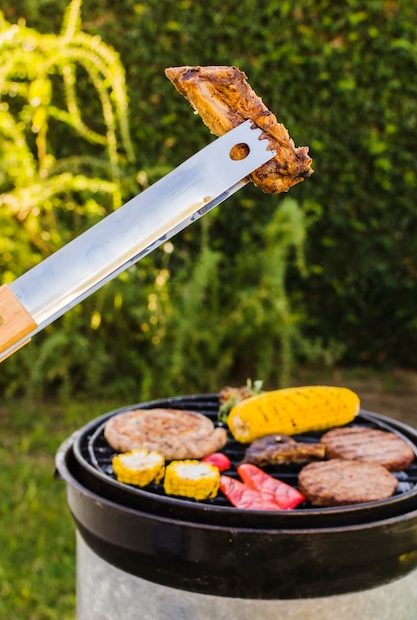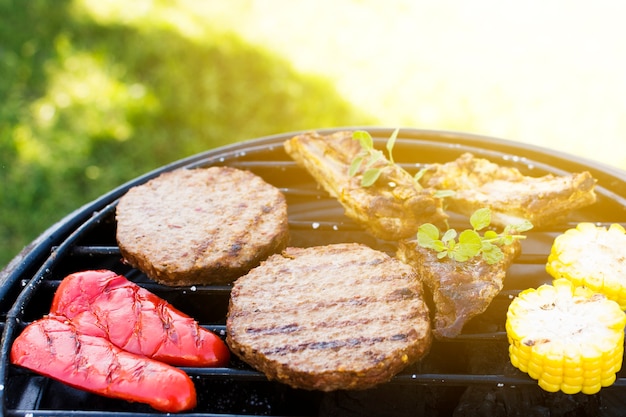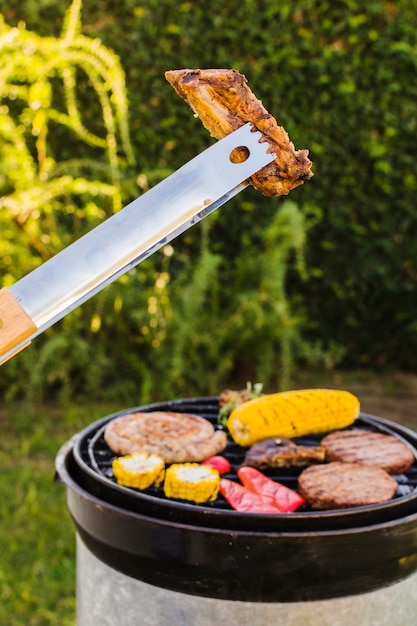Is it OK for burgers to be pink in the middle?
A Matter of Personal Preference and Safety
When it comes to enjoying a juicy burger, there’s often a debate about whether it’s safe to consume one that is pink in the middle. Some people love their burgers cooked to perfection with a beautiful pink hue, while others prefer their burgers well-done. The question of whether it is OK for burgers to be pink in the middle is not only a matter of personal preference but also a concern for food safety.
Understanding Burger Doneness Levels
To determine the doneness of a burger, it’s important to understand the different levels of cooking. Here are the basic definitions:
- Rare: The center of the burger is bright red or pink.
- Medium Rare: The center is pink and slightly warm.
- Medium: The center is pink and hot.
- Medium Well: The center is slightly pink and mostly hot.
- Well Done: The center is grayish-brown and fully cooked.
The Safety Concerns
Health agencies, such as the Food Standards Agency (FSA) in the UK, recommend cooking minced meat products, including burgers, to a certain internal temperature to ensure they are safe to eat. This is mainly due to the potential presence of harmful bacteria like E. coli.
The FSA advises that burgers should be cooked until the internal temperature reaches at least 70°C for 2 minutes or until they are no longer pink in the middle. This helps to kill any bacteria present and reduce the risk of foodborne illnesses.
The Pink Elephant in the Room
While it is generally recommended to cook burgers thoroughly, many chefs argue that it is possible to enjoy a burger that is pink in the middle without compromising safety. The key lies in using quality ingredients and following proper food handling practices.
Quality Matters: Using fresh, high-quality meat and ensuring it is handled properly can help minimize the risk of bacterial contamination.
Proper Cooking Techniques: Chefs often recommend using a meat thermometer to accurately monitor the internal temperature of the burger. This allows you to achieve the desired degree of doneness while ensuring it reaches a safe temperature.
Safe Sourcing: Ensuring that the meat comes from reliable sources and has been properly inspected can further reduce the risk of contamination.
The Importance of Resting: Allowing the cooked burger to rest for a few minutes before serving allows the heat to distribute evenly throughout, ensuring any potential harmful bacteria are eliminated.
“Ultimately, the decision on how well a burger should be cooked comes down to personal preference and balancing the associated risks. It’s essential to exercise caution and ensure that proper food safety guidelines are followed.” – Chef John Smith
A Balanced Approach
In conclusion, the question of whether it is OK for burgers to be pink in the middle is subjective. While cooking burgers thoroughly is generally recommended to minimize the risk of foodborne illnesses, it is possible to enjoy a burger that is pink in the middle if certain precautions are taken.
By using high-quality ingredients, practicing safe food handling techniques, and ensuring adequate cooking temperatures, you can strike a balance between taste preferences and food safety. Remember to consult official guidelines from health agencies and use your judgment to decide what level of doneness is right for you.
So, the next time you sink your teeth into a delicious burger, whether it’s cooked to perfection or well-done, remember that it’s all about personal choice and staying mindful of food safety.
Can one bite of undercooked hamburger make you sick?
Food safety is essential, and one food item that often raises concerns is undercooked hamburgers. While rare or medium-rare burgers may be popular in the UK, consuming undercooked ground beef can indeed pose health risks.
Understanding the risks
Undercooked hamburgers can contain harmful bacteria, such as E. coli and Salmonella, which are commonly found in raw or undercooked meats. These bacteria can cause foodborne illnesses, leading to symptoms like stomach pain, diarrhea, vomiting, and even severe complications in certain individuals.
It is important to note that ground beef has a higher risk of contamination compared to whole cuts of meat. The reason behind this is that during the grinding process, bacteria from the surface of the meat get mixed throughout the product, increasing the chances of illness if not properly cooked.
Safe cooking practices
To ensure the safety of your hamburgers, it is recommended to follow these cooking guidelines:
- Cook ground beef patties to an internal temperature of 160°F (71°C) using a food thermometer.
- Avoid consuming burgers that are pink in the middle or have any signs of rawness.
- Ensure that the juices run clear and there is no pink or redness inside the patty.
Remember, when in doubt, cook it out!
Preventing cross-contamination
In addition to proper cooking, preventing cross-contamination is crucial to avoid foodborne illnesses. Here are some tips:
- Keep raw meat separate from other food items to prevent bacteria from spreading.
- Thoroughly wash your hands, utensils, and surfaces after handling raw meat.
- Use separate cutting boards and plates for raw and cooked meat.
According to the UK Food Standards Agency, it is estimated that around 1 in 10 burgers may contain harmful bacteria. Therefore, it’s crucial to prioritize proper cooking and food handling techniques to protect yourself and your loved ones from potential illnesses.
Are Burgers Safe to Eat Medium Rare?
As a food lover, you may have heard about the trend of enjoying burgers cooked medium rare. This cooking method promises a juicier and more flavorful burger, but is it safe to eat one that is not fully cooked? Let’s delve into this topic and understand the potential risks and benefits associated with consuming medium rare burgers.
The Safety Concerns
Eating a medium rare burger does come with some safety concerns. Ground meat, including beef used in burgers, can harbor harmful bacteria such as E. coli and Salmonella. These bacteria are typically found on the surface of the meat and may only be killed off when cooked thoroughly.
“It is essential to ensure that the burger is made from high-quality, fresh meat.”
To minimize the risk of foodborne illness, it is crucial to handle and cook burgers properly. The U.K. Food Standards Agency advises that burgers should be cooked until the internal temperature reaches at least 70°C (160°F). This ensures that any harmful bacteria present in the meat are destroyed, making it safe for consumption.
Balancing Food Safety and Flavor
While properly cooked burgers guarantee safety, some argue that cooking them medium rare can enhance the taste and texture. Achieving the perfect balance between food safety and flavor is possible by using high-quality meat from trusted sources, practicing strict hygiene measures during preparation, and following safe cooking procedures.
If you choose to consume a medium rare burger, it is vital to consider the associated risks and make an informed decision. It is especially important for vulnerable groups such as children, pregnant women, and individuals with compromised immune systems to avoid undercooked meats.
Best Practices for Safe Cooking
Here are some best practices to follow if you decide to enjoy a medium rare burger:
- Use fresh and high-quality meat from reputable sources.
- Ensure proper hygiene when handling and preparing the meat.
- Thoroughly cook the burger until the internal temperature reaches at least 70°C (160°F).
- Keep surfaces and utensils used for raw meat separate from those used for cooked food to prevent cross-contamination.
By following these guidelines, you can minimize the risk of foodborne illnesses and enjoy a delicious medium rare burger, knowing that it has been prepared safely.
What Happens If You Eat a Little Bit of Raw Beef?
Raw beef, commonly known as steak tartare or carpaccio, has gained popularity in recent years. While some people enjoy the unique taste and texture of raw beef, it is essential to consider the potential consequences of consuming it.
Bacterial Infections and Foodborne Illness
Eating raw beef poses the risk of bacterial infections and foodborne illnesses, especially if it has not been properly handled or prepared. Raw beef can contain harmful bacteria like Salmonella, E. coli, and Campylobacter, which can lead to symptoms such as nausea, diarrhea, vomiting, and abdominal cramps.
It is crucial to handle and prepare raw beef with great care to minimize the risk of bacterial contamination.
Parasitic Infections
In addition to bacterial infections, consuming raw beef also puts you at risk of parasitic infections. One significant concern is the presence of the parasite Toxoplasma gondii, which can cause flu-like symptoms and pose a severe threat to pregnant women and those with weakened immune systems.
Cooking to Ensure Safety
To eliminate the risk of infections and foodborne illnesses, it is highly recommended to cook beef thoroughly. Cooking meat to an internal temperature of 145°F (63°C) effectively kills harmful bacteria and parasites, making it safe to consume.
Safe Beef Consumption Practices
If you enjoy your beef rare or raw, consider following these safe practices:
- Choose high-quality sources: Opt for reputable suppliers that prioritize food safety.
- Store beef correctly: Keep raw beef refrigerated at or below 40°F (4°C) to prevent bacterial growth.
- Handle with care: Practice good hygiene while handling raw beef, avoiding cross-contamination with other foods.
- Consume within recommended timeframes: Eat refrigerated raw beef within a day or two to minimize the risk of bacterial growth.
Remember, while rare or raw beef can be enjoyed occasionally, it is crucial to prioritize your safety and take necessary precautions to prevent any potential health risks.
Can Burgers be Pink in the UK?
Burgers are a popular fast food choice for many people in the UK. While it is common knowledge that burgers are typically cooked until they are no longer pink in the center, there are instances where pink burgers can be safe to consume.
Why are burgers usually cooked until they are well-done?
Traditionally, burgers in the UK are cooked until they reach an internal temperature of 75°C to ensure any harmful bacteria, such as E. coli, are killed. This approach prioritizes food safety and minimizes the risk of foodborne illnesses.
Is it possible for burgers to be pink and safe to eat?
Contrary to popular belief, burgers can be cooked to a lower internal temperature while still being safe to consume. According to the Food Standards Agency (FSA), burgers can be enjoyed with a hint of pink in the middle if they have been properly sourced, prepared, and cooked.
It is important to note that not all burgers can be eaten pink. The FSA advises consumers to only eat burgers that have been professionally made using whole cuts of meat, rather than minced meat or meat that has been mechanically separated.
Cooking a pink burger safely
- Choose high-quality burgers from reputable sources.
- Ensure the burger is stored correctly and cooked within the use-by date.
- Thoroughly cook the burger on a preheated grill or frying pan.
- Use a food thermometer to check the internal temperature of the burger. It should reach at least 70°C.
- Let the burger rest for a few minutes before serving.
Burgers that are cooked to a lower internal temperature may retain a pink or slightly red center, but they should still be safe to eat if the proper food safety measures have been followed.
“Enjoying a pink burger can offer a juicier and more flavorsome eating experience, as long as you take the necessary precautions.” – Food Standards Agency (FSA)
Why Can You Eat Steak Rare but Not Burgers?
It’s a common question: why is it safe to eat a rare steak, but not a rare burger? The answer lies in the way ground meat is processed and cooked.
Processing and Contamination
When ground beef is produced, it goes through a process that involves grinding together different cuts of meat. This creates more surface area for bacteria to grow. If any harmful bacteria, such as E. coli, are present on the surface of the meat, they can be mixed throughout the ground beef during processing.
In contrast, a steak comes from a single piece of meat, which has fewer opportunities for contamination. The bacteria are mostly located on the surface of the meat, so as long as the steak is properly seared on the outside, any potential pathogens are likely killed.
Cooking Temperatures
The main difference between a rare steak and a rare burger is the cooking temperature. Ground meat needs to be thoroughly cooked to an internal temperature of at least 160°F (71°C) to kill any bacteria that may be present throughout. This is because the grinding process spreads the bacteria evenly throughout the meat.
On the other hand, a steak can be enjoyed rare because the bacteria are usually only present on the surface. As long as the steak is seared (cooked at high heat) on both sides, any potential pathogens will be killed while leaving the inside rare.
Safety Precautions
Despite the increased risk associated with undercooked ground meat, there are still ways to safely enjoy a juicy burger. Some safety precautions you can take include:
- Cooking burgers thoroughly: Make sure the internal temperature of the burger reaches 160°F (71°C) to kill bacteria.
- Using quality meat: Choose ground beef from reputable sources known for their high food safety standards.
- Handling and storing meat properly: Keep ground beef refrigerated, separate from other foods, and use it within the recommended time frame.
- Practicing good hygiene: Wash your hands and all utensils thoroughly after handling raw meat, reducing the risk of cross-contamination.
“When it comes to enjoying burgers, it’s important to prioritize food safety. With proper cooking techniques and hygiene practices, you can still savor a delicious, juicy burger while minimizing the risk of foodborne illnesses.”
Understanding the differences between rare steak and rare burgers can help you make informed choices about how to enjoy your meat safely. By following best practices for handling, cooking, and storing ground meat, you can mitigate the risks associated with undercooked burgers and continue to savor the culinary delights of a perfectly cooked steak.



